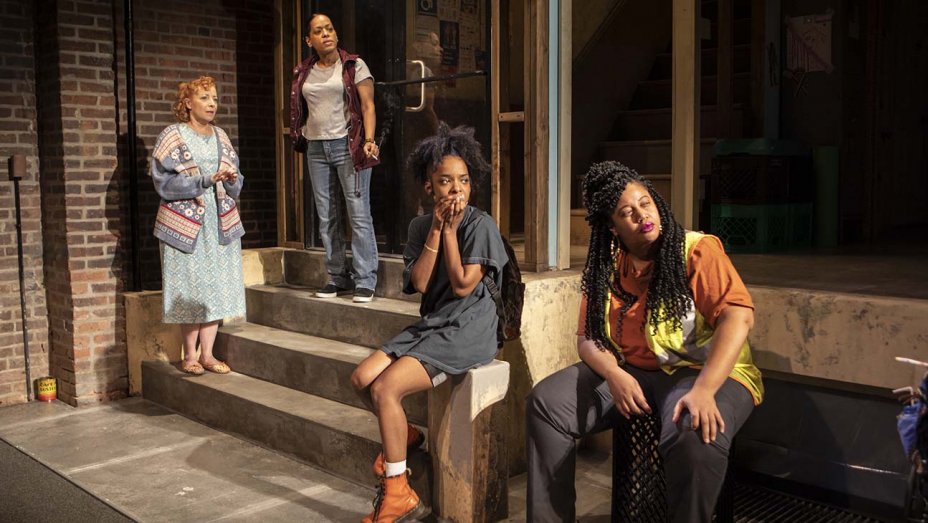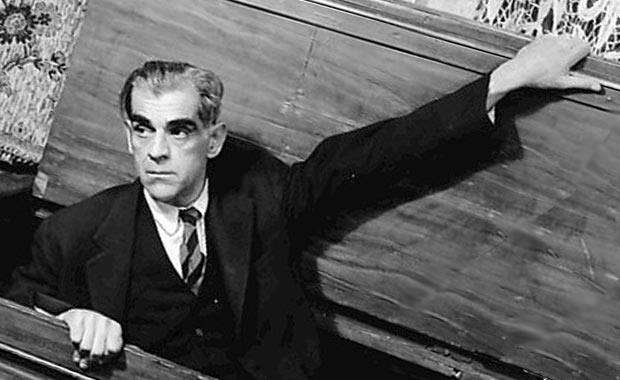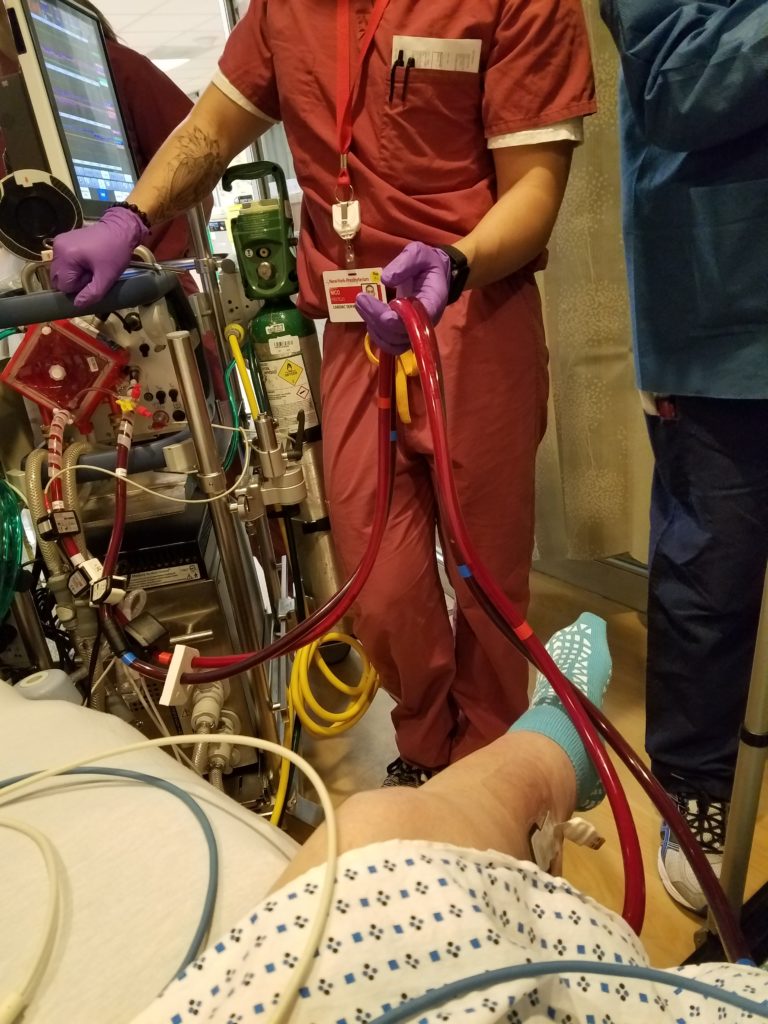“Love is an act of faith, and whoever is of little faith is also of little love.”
Erich Fromm, The Art of Loving
Terry Teachout on the arts in New York City
“Love is an act of faith, and whoever is of little faith is also of little love.”
Erich Fromm, The Art of Loving
* * *
Stephen Adly Guirgis is on a prolonged roll. “The Motherf**ker With the Hat” and “Between Riverside and Crazy,” his most recent plays, were serious comedies of urban life whose well-constructed plots kept them roaring down the dramatic track and whose smart, crackling dialogue had all the idiomatic savor of August Wilson at his best. Who knew that the sophomoric author of such earlier plays as “The Last Days of Judas Iscariot” would become a purveyor of taut moral tales that are also richly funny?…

Now the Atlantic Theater Company and LAByrinth Theater Company, Mr. Guirgis’ home base, have collaborated on a new play in a similar vein with an equally dumb title, “Halfway Bitches Go Straight to Heaven.” (I really wish he’d seek outside counsel when naming his shows.) The results, once again, are purest delight, all the more so because Mr. Guirgis has turned over a fresh leaf in his writer’s notebook. Unlike its more tightly wrought predecessors, “Halfway Bitches” is a big-cast ensemble piece set in a halfway house for troubled women whose near-plotlessness reminded me of nothing so much as one of Chekhov’s group portraits of turn-of-the-century Czarist Russia on the verge of revolution. It is, truth to tell, a bit too long—nearly three hours—but I wouldn’t want to have to cut it, for “Halfway Bitches,” for all its “Heartbreak House”-like looseness of structure, is so excitingly eventful that your attention will never wander.
Most of Mr. Guirgis’ 20 characters, played by 18 just-right actors, are the staff and occupants of Hope House, described in the script as “a government-funded residence for women providing transitional shelter and support for women in need in New York City.” Some drink, some use drugs, while others seek to break themselves of the no less devastating “habit” of being battered by their faithless partners….
I don’t want to single out any of the actors in “Halfway Bitches” for particular praise, since they’re all giving performances so real that you’ll feel as though you’d recognize their characters if you ran into them on Ninth Avenue after the show….
* * *
Read the whole thing here.Shirley Temple is interviewed by Michael Parkinson on Parkinson. This episode was originally telecast by the BBC on July 22, 1972:
(This is the latest in a series of arts- and history-related videos that appear in this space each Monday, Wednesday, and Friday)
“When people put their ballots in the boxes, they are, by that act, inoculated against the feeling that the government is not theirs. They then accept, in some measure, that its errors are their errors, its aberrations their aberrations, that any revolt will be against them. It’s a remarkably shrewd and rather conservative arrangement when one thinks of it.”
John Kenneth Galbraith, The Age of Uncertainty
In today’s Wall Street Journal “Sightings” column I recall the career of Boris Karloff, who was as fine a stage actor as he was a movie star. Here’s an excerpt.
* * *
Chuck Jones’ much-loved 1966 animated version of Dr. Seuss’ “How the Grinch Stole Christmas” will be telecast for the umpteenth time by NBC on Christmas night. The narrator is Boris Karloff, whose speaking voice (he sounded like a kindly Edwardian uncle) will be familiar to anyone who’s seen “Grinch,” though he was far better known in his own day for having played the heavily made-up monster in James Whale’s 1931 screen adaptation of “Frankenstein,” the movie that made him a full-fledged star. Julie Harris, who later appeared opposite Karloff on Broadway and TV, called him “a great actor…He had an enormous warmth and humanity, and this fascinating darker quality. It was mysterious. You wanted to know where such a man came from.” But unless you’re old enough to have seen “Frankenstein,” it’s possible that you won’t recognize his name—and you certainly won’t know that there was far more to him than the monsters and madmen he played on screen….

As a result of the success of “Frankenstein,” alas, he was permanently typecast, and spent the rest of his life appearing in horror films that were mostly of indifferent quality (remember “Abbott and Costello Meet Dr. Jekyll and Mr. Hyde”?). A few of them, fortunately, above all “The Body Snatcher” (1945) and “Bedlam” (1946), produced by Val Lewton, and “Targets” (1968), Peter Bogdanovich’s first feature film, were more than good enough to suggest how sensitive an actor he was beneath the bogeyman makeup that he often wore on screen….
Karloff’s first real opportunity to show his stuff came when, in 1941, he returned to the stage after a long absence—in a comedy. He made his Broadway debut in the original production of “Arsenic and Old Lace,” Joseph Kesselring’s now-classic black farce, which ran for 1,444 performances. In it, he created the role of Jonathan Brewster, a psychopathic mass murderer whose life is ruined when an alcoholic plastic surgeon inadvertently makes him look like—yes—Boris Karloff.
At first he was terrified by the thought of acting in front of live audiences after having spent so long in Hollywood. A month after the show opened, he recalled, “I got on the scales and I had lost 26 pounds—in sheer fright.” But to everyone’s amazement, his own included, he turned out to have a knack for comedy, and the rave reviews that he received for “Arsenic” inspired him to continue performing in plays as a more artistically fulfilling sideline….
* * *
Read the whole thing here.Julie Harris, Boris Karloff, and Basil Rathbone star in the 1957 Hallmark Hall of Fame TV version of the Broadway production of The Lark, Lillian Hellman’s English-language version of Jean Anouilh’s 1953 retelling of the story of Joan of Arc:
A live TV version of Joseph Conrad’s Heart of Darkness, starring Roddy McDowell, Eartha Kitt, and Boris Karloff and originally telecast live on Playhouse 90. Adapted by Stewart Stern and directed by Ron Winston, this program was originally telecast by CBS on November 6, 1958:
“Democracy is still upon its trial. The civic genius of our people is its only bulwark.”
William James, “Robert Gould Shaw: Oration upon the Unveiling of the Shaw Monument”
It was also misleading—deliberately so. That has also been our custom.
No more. Mrs. T, who is a very private person (that’s why I refer to her as “Mrs. T” in this space) and thus has been reluctant to be entirely frank about her illness in public, decided last night that it is time at last for me to start writing with complete candor about the increasingly desperate state of her health.
So…here goes.

To begin with, her condition has been declining steadily for the past couple of years, and that decline picked up speed a few months ago. She is much sicker now than when I first wrote about her need for a transplant in 2017. Except for doctor visits, she’s been housebound since late summer—she spends virtually all of her time in bed or on the living-room couch—and her vital signs have gradually sunk to the low side of what for her long ago became “normal.”
On Saturday evening, her blood oxygen saturation level, the statistic that is the most critical indicator of her minute-to-minute condition, became alarmingly unstable, then plummeted downward, from 75% to 40%. (One hundred percent is normal.) We knew this to be a possible sign that the right ventricle of her heart was starting to decompensate and fail—something that typically happens sooner or later to patients in the end stage of primary pulmonary hypertension, the rare and fatal illness from which Mrs. T suffers. Our standing instructions are to call 911 should her sat level suddenly drop by a significant amount and fail to rebound. We did so, and an ambulance arrived within minutes and rushed us to the emergency room of New York-Presbyterian Hospital, a mile from our front door.
Twenty-four nerve-racking hours later, Mrs. T was transferred to the intensive-care unit around the corner, where the doctors were unable to bring her blood oxygen up to a safe level. For this reason, they decided to hook her up to an ECMO machine, a new kind of heart-lung machine that continuously oxygenates a patient’s blood supply.
What I didn’t tell you on Monday is that the use of an ECMO machine is a last-resort measure. Moreover, the ICU doctors were far from certain that it would solve her problem. In fact, they warned me—not in so many words but straightforwardly, which was what I wanted—that there was a good chance she was about to die.
As I sat in the corridor waiting for the machine to be connected to her body, I recalled a pair of numbers that everyone who needs a transplant knows by heart:
• As of this hour, 113,000 Americans are waiting for a transplant that could save their lives.
• Roughly twenty of them will die waiting today, and another twenty tomorrow and the day after that, because of a chronic shortage of donor organs nationwide.
I thought: Is the woman I love about to become one of those people?
Then one of the doctors came out to me, smiled broadly, and said, “It’s working. The machine is hooked up. Her oxygen level is 100%.”
No sooner did he speak those words than my stomach heaved, and I came close to vomiting on the floor. Then I started crying.
It is not even remotely true to say that Mrs. T is out of danger. Her doctors believe that she will probably have to remain in the ICU, hooked up to an ECMO machine, until a compatible pair of donor lungs finally becomes available—or until her body wears out and she dies, which will happen sooner or later.

Meanwhile, she is waiting as patiently as she can, suffering as she does so (as has been the case for several years) from nonstop, at times excruciating pain that can only be eased with opiates, relieving herself through a Foley catheter because she is too fragile to use a urinal or a bedside commode, unable to do much of anything but read, watch movies, play electronic solitaire, and post the odd message on Facebook.
I spend several hours sitting with her each day, though there isn’t much room to spare in her tiny cubicle, most of which is now occupied by the half-dozen units that comprise the complicated machine that is keeping her alive. (At right is a snapshot taken by Mrs. T that shows part of the ECMO machine at work. That’s her blood flowing through the red hose.)
I’ve said it before, but I can’t possibly say it often enough: Mrs. T is tougher and more gallant than anyone I know. She’s not going down without a fight. But she’s been fighting for a long, long time, and she’s tired. It’s true that she’s been moved to the very top of New York-Presbyterian’s lung-transplant priority list as a result of her being put on the ECMO machine. Unfortunately, it’s far from a sure thing that she’ll receive a compatible pair of donor lungs in time to keep her alive. In the six months since the New York-Presbyterian transplant team told her that she was sick enough to start receiving organ offers, we’ve gotten only two Big Calls, both of them dry runs that didn’t pan out.The rest—so far—is silence.
* * *
You now know exactly what’s up with us. The bark, as they say, is off. Yes, we’re coping as best as we can, and we’ll continue to do so. There’s nothing the two of us love more than being together, and there’s nothing we want more than to be able to return to our beloved Sanibel Island, walk on the beach hand in hand, and listen to the soothing sound of the surf. We’re tired of keeping our cellphones turned on 24/7 in the hope of getting a Big Call that will change our lives. We’re tired of pain and fear and middle-of-the-night crises. We’re ready for a change.

We also know—really, really know—that in order for these things to end, an unknown person of short stature with two good lungs and A-positive-compatible blood will have to die, sooner rather than later.
That is a terrible fact with which to live day in and day out, at least as terrible as Mrs. T’s grueling everyday suffering. Yet it is something both of us have learned, however reluctantly, to accept. It is the plain truth about organ donation, a cruel truth—and a beautiful one.
To all of you out there who have sent us your good wishes in recent weeks, we bless you for them. Your messages are among the few things that can put a smile on her weary face when she’s having one of her bad days. But please permit me to ask you for one more thing: if you haven’t signed up to be an organ donor, do it now.
Mrs. T and a hundred thousand other sick Americans need your help. Their lives are in your hands.

In today’s Wall Street Journal I offer a brief summary of key trends in American theater during the past decade, part of an ongoing series of reports by the paper’s arts critics. Here’s an excerpt:
Read the whole thing here.Ten years ago, close observers of the theater scene would likely have agreed that most of the main figures in American theater, actors excluded, were men. But things were already changing in 2010, and I don’t know anyone who’d make such a claim today. To the contrary, American theater is now well on the way to becoming a woman’s game….
Whatever the reasons, the shift is here to stay. So is an equally consequential shift that is, however, in no way desirable: The Broadway-style American musical has entered a period of creative decline….
| M | T | W | T | F | S | S |
|---|---|---|---|---|---|---|
| 1 | 2 | |||||
| 3 | 4 | 5 | 6 | 7 | 8 | 9 |
| 10 | 11 | 12 | 13 | 14 | 15 | 16 |
| 17 | 18 | 19 | 20 | 21 | 22 | 23 |
| 24 | 25 | 26 | 27 | 28 | 29 | 30 |
| 31 | ||||||
An ArtsJournal Blog